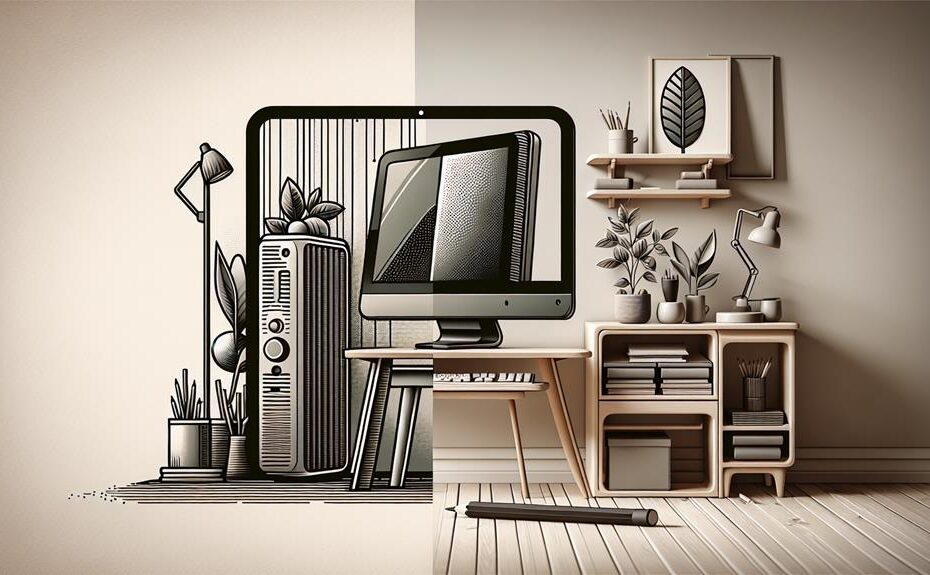



Did you know that the mini PCs and all-in-one systems, both designed for compactness, differ greatly in their feature sets? That might be news to you. The question now becomes which one to choose. Both mini PCs and all-in-one systems have unique strengths and weaknesses. Mini PCs provide unparalleled flexibility and space efficiency, while all-in-one systems excel in cable management. In addition, each option has distinct performance and upgrade capabilities. What you decide depends on your specific needs and priorities, but by the end of this journey, you'll have all the information needed to make an informed choice.
Key Takeaways
- Mini PCs offer a highly compact and space-saving design compared to all-in-one computers.
- Mini PCs are more cost-effective for general computing needs and allow for easier component upgrades.
- All-in-one computers have an integrated design that reduces cable clutter, providing a neater workspace.
- High-end mini PCs can offer comparable or better performance than all-in-one computers.
- The choice between mini PCs and all-in-one computers depends on specific requirements, priorities, and available space.
Mini PCs and All-in-One Systems
When choosing between a mini PC and an all-in-one (AIO) system, it's vital to ponder that mini PCs are designed to be highly compact, while AIO computers integrate all components into a single unit, influencing your overall selection based on available space, performance needs, and budget. Take, for example, the typical desktop PC setup. It consists of a separate tower, monitor, and peripherals. Both mini PCs and AIO computers help streamline this setup by reducing the overall footprint, but they differ in how they do so. Mini PCs compress the computer into a small box, focusing on minimalistic design and portability. They are ideal when desk space is limited and you need a computer that can be easily hidden or mounted.
On the other hand, AIO computers combine the computer and monitor into a single unit, providing a more integrated and sleek design. Both options have advantages and disadvantages. Mini PCs are generally more cost-effective and offer flexibility for upgrading individual components. AIO computers provide a more seamless and cable-free setup but can be more restrictive with regard to upgrade possibilities and higher in cost. The choice depends on your unique requirements and priorities.
Key Differences между Them
Typically, the choice between a mini PC and an all-in-one computer is guided by your available desk space, the need for a separate monitor, and your budget considerations. Mini PCs stand out due to their smaller footprint and compact form factor, making them ideal for cramped spaces. This size means that they require separate monitors, keyboards, and mice, which can lead to increased cable clutter but also offers flexibility in customizing your setup.
In contrast, all-in-one systems integrate the computer and monitor into a single unit, providing a seamless, cable-free experience. While they generally possess larger displays and integrated speakers, their compactness comes at the cost of restricted upgradability. Processintisayar and graphics card upgrades are often limited in AIOs, whereas mini PCs typically offer more flexibility for component upgrades. When considering processing power, mini PCs and AIOs generally provide sufficient performance for general tasks. However, if specific tasks require more advanced capabilities, separate components can be upgraded in mini PC setups, making them a more cost-effective option….
Comparative Space Usage
In regards to space efficiency, mini PCs outshine all-in-one computers with their drastically smaller footprint and ability to be easily mounted or hidden out of sight. This compact design makes them well-suited for space-constrained environments like commercial vehicles or small workstations where an all-in-one computer may simply not fit.
In contrast, all-in-one computers integrate the computer and monitor into a single unit, which, although reducing the overall space required compared to a separate desktop and monitor setup, still occupies a larger space equivalent to a monitor. Mini PCs can be easily mounted behind a monitor or hidden under a desk, making them ideal for clutter-free and organized workspaces.
Given the differences in their designs, if saving space and minimizing clutter is a priority, mini PCs are the clear choice. However, if you prefer a unified and integrated solution, an all-in-one computer might be the way to go.
Performance and Upgradability
Both mini PCs and all-in-one computers have distinct performance and upgradability profiles, making each suitable for different use cases and requirements.
Mini PCs, being compact and energy-efficient, often rely on laptop-grade components, which can result in lower performance compared to desktop-grade hardware used in all-in-one computers. This performance gap affects tasks that require robust processing and graphics capabilities. Unless you opt for high-end mini PCs, which can offer comparable or even better performance for tasks involving discrete graphics processing. However, upgrading components in mini PCs can be more challenging due to their small size, while AIOs often have limited upgrade options due to their integrated nature.
Interestingly, the modular design of mini PCs enables you to upgrade targeted components like RAM or storage. In contrast, AIOs may require replacing the entire system for significant performance boosts. This becomes pivotal for power-hungry applications and workloads that can benefit more from the greater capabilities found in AIO computers.
Cable Management and Clutter
When considering the cable management and clutter aspects of mini PCs and all-in-one computers, each option presents unique benefits. All-in-one computers eliminate the need for separate cables between the desktop and monitor, delivering a significant advantage in cable management by default. Since the computer components and monitor are integrated into a single unit, there are fewer external connections to manage, resulting in a neater workspace. This streamlined setup also reduces the likelihood of tangled cables and makes it easier to set up and maintain.
In contrast, mini PCs require connecting various cables for power, data, and peripherals, which can lead to clutter and disorganization if not properly managed. However, mini PCs do provide more flexibility in cable management, as the cables can be routed and hidden behind the computer or within the surrounding furniture. If you place a high value on a clutter-free environment and simplicity, an all-in-one computer might be the better choice for you.
Cost-Effectiveness and Budgeting
Mini PC cost-effectiveness is directly influenced by your existing setup, as having peripherals already means you won't need to factor in additional costs for monitors, keyboards, and mice. This makes mini PCs more budget-friendly for users who already have the necessary peripherals.
Mini PCs offer more customization options, allowing you to upgrade individual components as needed, which can extend the life of your system. All-in-one computers often come at a higher upfront cost due to their integrated design. In an AIO system, repairing or replacing components can be more expensive compared to a mini PC. Mini PCs can provide better value for users with tight budgets. Customization options in mini PCs can help you save money in the long run by avoiding the need for a full system replacement.
When evaluating cost-effectiveness, it is crucial to weigh these factors against your specific needs and budget.
Choosing the Ideal Option
Setting up a new computer system can raise questions about whether to choose a mini PC or an all-in-one (AIO) computer, and your ideal option largely depends on evaluating your environment, performance requirements, and upgrade needs.
If you have limited space and need a compact system, a mini PC is the better choice. They offer a considerably smaller footprint, making them ideal for tight desk spaces or clutter-free environments. Additionally, mini PCs can be a cost-effective option, generally being less expensive than AIO computers. For general tasks, such as web browsing, document editing, and media consumption, a mini PC's processing power is usually sufficient.
However, if you require better graphics capabilities, AIO computers might be the better fit. They often integrate more powerful components for improved performance. They also reduce cable clutter due to their integrated design. Ultimately, the choice between a mini PC and an AIO computer boils down to your specific needs and priorities.
Frequently Asked Questions
Are Mini PCS as Good as Desktops?
"Your mini PC can match desktop performance for basic tasks, but limited storage and cooling capacity may hinder heavier usage. It'll handle everyday tasks fine, but processing-intensive activities might be a struggle."
What Are the Limitations of Mini Pc?
"As you weigh mini PCs for your next device, keep in mindDataReader some important limitations. You might find they have limited storage capacity
What Is the Disadvantage of All-In-One Pc?
You'll find that all-in-one PCs have several drawbacks: limited upgradeability, storage capacity concerns due to integrated components, cooling challenges in compact designs, and port selection issues.
Are All-In-One PCS Worth It?
"While considering AIO PCs, weigh space requirements against price considerations. Though not the most portable option, they offer sleek designs. Be aware that performance capabilities may be limited, and customization options are restricted."
Conclusion
In the aisle of mini computers, you're faced with two distinct choices: Mini PCs and All-in-One computers. As you weigh your options, consider this: more than 60% of consumers prefer Mini PCs for their compact design and customization perks. For those who value cable efficiency and simplicity, All-in-One systems are a streamlined choice. Ultimately, the decision boils down to your specific needs and available space.
Disclosure: As an Amazon Associate, I earn from qualifying purchases.




